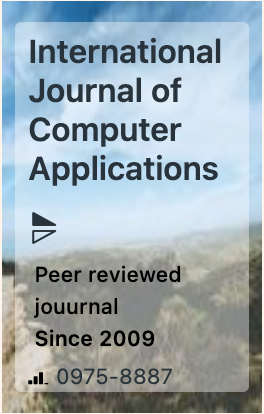The week's pick
Random Articles
Reseach Article
State of the Art and Emerging Trends in Indian Languages' Question-Answering Systems: An Overview
| International Journal of Computer Applications |
| Foundation of Computer Science (FCS), NY, USA |
| Volume 187 - Number 15 |
| Year of Publication: 2025 |
| Authors: Mamta S. Bendale, Rupali H. Patil, Bhausaheb V. Pawar |
 10.5120/ijca2025925185
10.5120/ijca2025925185
|
Mamta S. Bendale, Rupali H. Patil, Bhausaheb V. Pawar . State of the Art and Emerging Trends in Indian Languages' Question-Answering Systems: An Overview. International Journal of Computer Applications. 187, 15 ( Jun 2025), 49-60. DOI=10.5120/ijca2025925185
Abstract
As digital technologies continue to evolve, the demand for effective natural language processing (NLP) systems tailored to Indian languages has grown significantly. Most of the researchers has been concentrated on languages with rich digital resources, frequently failing to acknowledge the Indian subcontinent's linguistic diversity. This review paper seeks to address this deficiency by offering a thorough summary of the progress and improvements in Question Answering Systems(QASs), particularly for Indian languages. With 22 official languages recognized under the eighth schedule of the Indian Constitution, India has a vast linguistic variety. QASs are an essential part of NLP that try to understand user inquiries and provide human-like answers. In this study, an overview of QAS research for several Indian languages is presented. The analysis and outcomes regarding Categories of Indian Languages, Necessity of Indian Languages' Question-Answering Systems, applications of QAS and approaches of QAS’s are reported. This review distinguishes itself from previously available reviews by including languages such as Odia, Sanskrit, Kannada, Assamese, and others. The study also highlights that BERT and SVM are the most used models for developing QAS in various Indian languages. All conclusions are drawn based on a review of the literature.
References
- P. Gupta and V. Gupta, “A survey of text question answering techniques,” International Journal of Computer Applications, vol. 53, no. 4, 2012, Accessed: Jul. 15, 2024.
- Kumar, Praveen, Shrikant Kashyap, Ankush Mittal, and Sumit Gupta. "A Hindi question answering system for E-learning documents." In 2005 3rd International Conference on Intelligent Sensing and Information Processing, pp. 80-85. IEEE, 2005.
- O. Kolomiyets and M.-F. Moens, “A survey on question answering technology from an information retrieval perspective,” Information Sciences, vol. 181, no. 24, pp. 5412–5434, 2011.
- M. M. Biltawi, S. Tedmori, and A. Awajan, “Arabic question answering systems: gap analysis,” IEEE Access, vol. 9, pp. 63876–63904, 2021.
- “Indian Languages: Classification of Indian Languages.” Available at: https://www.yourarticlelibrary.com Accessed on: 27 November 2024.
- “Official Languages of India List with States PDF Map Classical,” Guidely. Available at: https://www.indianetzone.com Accessed on:15 July 2024.
- R. P. Patil, R. P. Bhavsar, and B. V. Pawar, “Automatic marathi text classification,” Int. J. Innovat. Technol. Expl. Eng, vol. 9, no. 2, pp. 2446–2454, 2019.
- H. T. Madabushi and M. Lee, “High accuracy rule-based question classification using question syntax and semantics,” in Proceedings of COLING 2016, the 26th international conference on computational linguistics: Technical Papers, 2016, pp. 1220–1230. Accessed: Jul. 15, 2024.
- E. Riloff and M. Thelen, “A rule-based question answering system for reading comprehension tests,” in ANLP-NAACL 2000 workshop: reading comprehension tests as evaluation for computer-based language understanding systems, 2000. Accessed: Jul. 15, 2024.
- S. M. Humphrey, A. Névéol, A. Browne, J. Gobeil, P. Ruch, and S. J. Darmoni, “Comparing a rule‐based versus statistical system for automatic categorization of MEDLINE documents according to biomedical specialty,” J. Am. Soc. Inf. Sci., vol. 60, no. 12, pp. 2530–2539, Dec. 2009, doi: 10.1002/asi.21170.
- K. S. D. Ishwari, A. K. R. R. Aneeze, S. Sudheesan, H. J. D. A. Karunaratne, A. Nugaliyadde, and Y. Mallawarrachchi, “Advances in Natural Language Question Answering: A Review,” Apr. 10, 2019, arXiv: arXiv:1904.05276. Accessed: Jul. 15, 2024.
- R. P. Patil, R. P. Bhavsar, and B. V. Pawar, “A NOTE ON INDIAN LANGUAGES TEXT CLASSIFICATION SYSTEMS,” Asian Journal of Mathematics and Computer Research, vol. 15, no. 1, pp. 41–55, 2017.
- S. K. Dwivedi and V. Singh, “Research and reviews in question answering system,” Procedia Technology, vol. 10, pp. 417–424, 2013.
- S. R. Muthutantrige and A. R. Weerasinghe, “Sentiment Analysis in Twitter messages using constrained and unconstrained data categories,” in 2016 Sixteenth International Conference on Advances in ICT for Emerging Regions (ICTer), IEEE, 2016, pp. 304–310. Accessed: Jul. 15, 2024.
- J. Schmidhuber, “Deep learning in neural networks: An overview,” Neural networks, vol. 61, pp. 85–117, 2015.
- M. Tan, C. dos Santos, B. Xiang, and B. Zhou, “LSTM-based Deep Learning Models for Non-factoid Answer Selection,” Mar. 28, 2016, arXiv: arXiv:1511.04108. Accessed: Jul. 15, 2024.
- Banerjee, S., Naskar, S. K., & Bandyopadhyay, S. (2014). Bfqa: A bengali factoid question answering system. In Text, Speech and Dialogue: 17th International Conference, TSD 2014, Brno, Czech Republic, September 8-12, 2014. Proceedings 17 (pp. 217-224). Springer International Publishing.
- Md. Kowsher, M. M. M. Rahman, S. S. Ahmed, and N. J. Prottasha, “Bangla Intelligence Question Answering System Based on Mathematics and Statistics,” in 2019 22nd International Conference on Computer and Information Technology (ICCIT), Dhaka, Bangladesh: IEEE, Dec. 2019, pp. 1–6. doi: 10.1109/ICCIT48885.2019.9038332.
- A. Das, J. Mandal, Z. Danial, A. Pal, and D. Saha, “A novel approach for automatic Bengali question answering system using semantic similarity analysis,” Int J Speech Technol, vol. 23, no. 4, pp. 873–884, Dec. 2020, doi: 10.1007/s10772-020-09760-5.
- T. Tahsin Mayeesha, A. Md Sarwar, and R. M. Rahman, “Deep learning based question answering system in Bengali,” Journal of Information and Telecommunication, vol. 5, no. 2, pp. 145–178, Apr. 2021, doi: 10.1080/24751839.2020.1833136.
- A. Das and D. Saha, “Deep learning based Bengali question answering system using semantic textual similarity,” Multimed Tools Appl, vol. 81, no. 1, pp. 589–613, Jan. 2022, doi: 10.1007/s11042-021-11228-w.
- S. Sekine and R. Grishman, “Hindi-english cross-lingual question-answering system,” ACM Transactions on Asian Language Information Processing, vol. 2, no. 3, pp. 181–192, Sep. 2003, doi: 10.1145/979872.979874.
- S. Sahu, “Prashnottar: A Hindi Question Answering System,” IJCSIT, vol. 4, no. 2, pp. 149–158, Apr. 2012, doi: 10.5121/ijcsit.2012.4213.
- M. Dua, S. Kumar, and Z. S. Virk, “Hindi Language Graphical User Interface to Database Management System,” in 2013 12th International Conference on Machine Learning and Applications, Miami, FL, USA: IEEE, Dec. 2013, pp. 555–559. doi: 10.1109/ICMLA.2013.176.
- R. Kumar, M. Dua, and S. Jindal, “D-HIRD: Domain-independent Hindi language Interface to Relational Database,” in 2014 International Conference on Computation of Power, Energy, Information and Communication (ICCPEIC), Chennai, India: IEEE, Apr. 2014, pp. 81–86. doi: 10.1109/ICCPEIC.2014.6915344.
- G. Nanda, M. Dua, and K. Singla, “A hindi question answering system using machine learning approach,” in 2016 international conference on computational techniques in information and communication technologies (ICCTICT), IEEE, 2016, pp. 311–314. Accessed: Dec. 05, 2023.
- Gupta, Deepak, Surabhi Kumari, Asif Ekbal, and Pushpak Bhattacharyya. "MMQA: A multi-domain multi-lingual question-answering framework for English and Hindi." In Proceedings of the eleventh international conference on language resources and evaluation (LREC 2018). 2018.
- Stalin, Shalini, Rajeev Pandey, and Raju Barskar. "Web based application for hindi question answering system." International Journal of Electronics and Computer Science Engineering 2, no. 1 (2012): 72-78.
- A. Thirumala and E. Ferracane, “Extractive Question Answering on Queries in Hindi and Tamil,” Sep. 26, 2022, arXiv: arXiv:2210.06356. Accessed: Dec. 05, 2023.
- I. T. Seena, G. M. Sini, and R. Binu, “Malayalam Question Answering System,” Procedia Technology, vol. 24, pp. 1388–1392, 2016, doi: 10.1016/j.protcy.2016.05.155.
- S. M. Archana, N. Vahab, R. Thankappan, and C. Raseek, “A Rule Based Question Answering System in Malayalam Corpus Using Vibhakthi and POS Tag Analysis,” Procedia Technology, vol. 24, pp. 1534–1541, 2016, doi: 10.1016/j.protcy.2016.05.124.
- L. S. K and M. I. P, “‘A Neural Word Embedding Based Transformer Model for Improving Malayalam Question Answering on Health Domain,’” International Journal of Intelligent Systems and Applications in Engineering, vol. 12, no. 14s, Art. no. 14s, Feb. 2024.
- P. Dalvi, V. Mandave, M. Gothkhindi, A. Patil, S. Kadam, and S. Pawar, “ONTOLOGY EXTRACTION FOR AGRICULTURE DOMAIN IN MARATHI LANGUAGE USING NLP TECHNIQUES.,” ICTACT Journal on Soft Computing, vol. 7, no. 1, 2016, Accessed: Dec. 05, 2023.
- S. S. Govilkar and B. J. W, “Question Answering System Using Ontology in Marathi Language,” IJAIA, vol. 8, no. 4, pp. 53–64, Jul. 2017, doi: 10.5121/ijaia.2017.8405.
- A. Phade and Y. Haribhakta, “Question Answering System for low resource language using Transfer Learning,” in 2021 International Conference on Computational Intelligence and Computing Applications (ICCICA), IEEE, 2021, pp. 1–6. Accessed: Dec. 05, 2023.
- B. A. Shelke and C. N. Mahender, “Development of Question Answering System in Marathi Language,” Specialusis Ugdymas, vol. 1, no. 43, pp. 10176–10185, 2022.
- Amin, Dhiraj, Sharvari Govilkar, and Sagar Kulkarni. "Question answering using deep learning in low resource Indian language Marathi." arXiv preprint arXiv:2309.15779 (2023).
- V. Gupta, “A Proposed Online Approach of English and Punjabi Question Answering,” International Journal of Engineering Trends and Technology, vol. 6, no. 5, 2013.
- G. S. Dhanjal, S. Sharma, and P. K. Sarao, “Gravity based Punjabi question answering system,” International Journal of Computer Applications, vol. 147, no. 3, p. 21, 2016.
- R. Sankaravelayuthan, M. Anandkumar, V. Dhanalakshmi, and S. N. Mohan Raj, “A Parser for Question-answer System for Tamil,” QA System Using DL, vol. 229, p. 230, 2019.
- R. V. Namasivayam and M. Rajan, “Answer Prediction for Questions from Tamil and Hindi Passages,” Procedia Computer Science, vol. 218, pp. 1985–1993, 2023.
- Sarma, Shikhar Kr, and Rita Chakraborty. "Structured and Logical Representations of Assamese Text for Question-Answering System." In Proceedings of the Workshop on Question Answering for Complex Domains, pp. 27-38. 2012.
- R. C. Balabantaray, B. Sahoo, S. K. Lenka, D. K. Sahoo, and M. Swain, “An Automatic Approximate Matching Technique Based on Phonetic Encoding for Odia Query,” vol. 9, no. 3, 2012.
- P. Ajawan, V. Desai, S. Kale, and S. Patil, “Krishiq-BERT: A Few-Shot Setting BERT Model to Answer Agricultural-Related Questions in the Kannada Language,” J. Inst. Eng. India Ser. B, vol. 105, no. 2, pp. 285–296, Apr. 2024, doi: 10.1007/s40031-023-00952-6.
- Terdalkar, Hrishikesh, and Arnab Bhattacharya. "Framework for question-answering in Sanskrit through automated construction of knowledge graphs." arXiv preprint arXiv:2310.07848 (2023).
- P. Gupta and V. Gupta, “Hybrid Approach for Punjabi Question Answering System,” in Advances in Signal Processing and Intelligent Recognition Systems, vol. 264, S. M. Thampi, A. Gelbukh, and J. Mukhopadhyay, Eds., in Advances in Intelligent Systems and Computing, vol. 264. , Cham: Springer International Publishing, 2014, pp. 133–149. doi: 10.1007/978-3-319-04960-1_12.
Index Terms
Keywords

